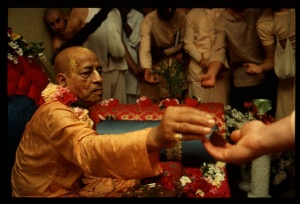SB 7.7.23

A.C. Bhaktivedanta Swami Prabhupada
TEXT 23
- dehas tu sarva-saṅghāto
- jagat tasthur iti dvidhā
- atraiva mṛgyaḥ puruṣo
- neti netīty atat tyajan
SYNONYMS
dehaḥ — the body; tu — but; sarva-saṅghātaḥ — the combination of all the twenty-four elements; jagat — seen to be moving; tasthuḥ — and standing in one place; iti — thus; dvidhā — two kinds; atra eva — in this matter; mṛgyaḥ — to be searched for; puruṣaḥ — the living entity, the soul; na — not; iti — thus; na — not; iti — thus; iti — in this way; atat — what is not spirit; tyajan — giving up.
TRANSLATION
There are two kinds of bodies for every individual soul—a gross body made of five gross elements and a subtle body made of three subtle elements. Within these bodies, however, is the spirit soul. One must find the soul by analysis, saying, "This is not it. This is not it." Thus one must separate spirit from matter.
PURPORT
As previously stated, svarṇaṁ yathā grāvasu hema-kāraḥ kṣetreṣu yogais tad-abhijña āpnuyāt. An expert in the study of soil can find out where gold is and then dig there. He can then analyze the stone and test the gold with nitric acid. Similarly, one must analyze the whole body to find within the body the spirit soul. In studying one's own body, one must ask himself whether his head is his soul, his fingers are his soul, his hand is his soul, and so on. In this way, one must gradually reject all the material elements and the combinations of material elements in the body. Then, if one is expert and follows the ācārya, he can understand that he is the spiritual soul living within the body. The greatest ācārya, Kṛṣṇa, begins His teachings in Bhagavad-gītā by saying:
- dehino 'smin yathā dehe
- kaumāraṁ yauvanaṁ jarā
- tathā dehāntara-prāptir
- dhīras tatra na muhyati
"As the embodied soul continually passes, in this body, from boyhood to youth to old age, the soul similarly passes into another body at death. The self-realized soul is not bewildered by such a change." (BG 2.13) The spirit soul possesses the body and is within the body. This is the real analysis. The soul never mixes with the bodily elements. Although the soul is within the body, it is separate and always pure. One must analyze and understand his self. This is self-realization. Neti neti is the analytical process of rejecting matter. By expertly conducting such an analysis, one can understand where the soul is. One who is not expert, however, cannot distinguish gold from earth, nor the soul from the body.